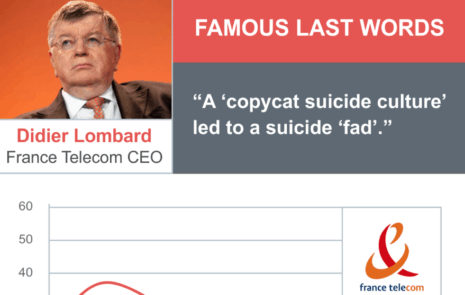
Top 100 Content Marketing Question: What are the must-haves when building a content marketing strategy from scratch?

To build a content marketing strategy from scratch, get internal buy-in.
How? Here’s the short answer:
Inside the company, build buy-in by collaborating with colleagues to co-create your content marketing mission, strategy, and message.
Use buyer persona research or customer question analysis to gain crucial insights into what buyers need.
Here’s a step-by-step process for how to build a content marketing strategy from scratch:
1. Secure buy-in through co-creation
It’s not easy to gain buy-in. In fact, the #1 challenge business-to-business (B2B) marketers face is getting content marketing to fit into the company, its culture, and its organization chart.
To secure buy-in from executives, R&D, sales, and marketing, “co-create” your content marketing platform.

How? Convene a team that gives voice to other people on the company’s content marketing mission, strategy, message, and editorial calendar.
A co-creation approach is the most effective way to get the right issues debated, create understanding across departments, and move everyone onto the same page for implementation. Use a neutral facilitator to speed up the process.
You can start to co-create content marketing strategy in any of 3 places:
• To start at the corporate level, involve the CEO and direct reports.
• Starting at a product level, include the business unit head, division manager, product manager, sales, R&D and marketing.
• To start at a regional sales level, work with the regional sales manager, key product managers, sales and marketing.
2. Gather buyer insights
To build your strategy on solid ground, bring to the table everything you know about customers and buyers.

When you perform buyer persona research in advance of the first strategy meeting, you can bring useful insights from buyers to the team. For example, you’ll learn:
• What event triggered the need to start a buying journey?
• Which media do buyers use?
• Which information do buyers seek?
• What obstacles do buyers encounter?
• How exactly do buyers overcome the obstacles to making a purchase?
It’s important to see what buyers do when they’re offstage: here’s why. And here’s more information on how to perform your own buyer persona research.
If you don’t have buyer persona research or lack the resources for it, then focus on finding out your customers’ top 100 questions.
Capture customer questions face-to-face, by phone, on the Internet, or via BuzzSumo’s question analyzer. Here’s a step-by-step process to help you transform customer questions into compelling content.
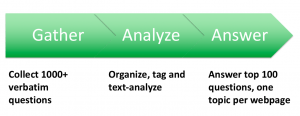
After you have gathered 1,000 or more questions, use text analysis to find out:
• What are customers’ top 100 questions?
• What do questions show about the buying journey?
• Which obstacles prevent potential buyers from reaching a decision?
With these insights, you can create content that answers customers’ questions best.
3. Simplify with a one-page strategy
Most marketers lack a written content marketing strategy. That’s nutty because a written strategy makes you 4 times more successful.

Don’t make content marketing strategy into the daunting process of creating a 3-inch binder no one reads.
Boil down your strategy to its essence on one page. Use the one-page strategy template below to align content marketing with business needs.

The content marketing strategy template builds on an OGSM framework:
• Objectives: What are 2 or 3 things the company must do in the year ahead? Or, what are the top 2 or 3 items on the CEO’s to-do list? (qualitative)
• Goals: How will the company measure the achievement of its objectives? (quantitative)
• Strategy: What will marketing do to support the achievement of these objectives? (qualitative)
• Metrics: How will marketing measure the achievement of strategies? (quantitative)
Then, you need to plug in your content marketing mission. If you don’t have a written content marketing mission, you can create your own with this template.
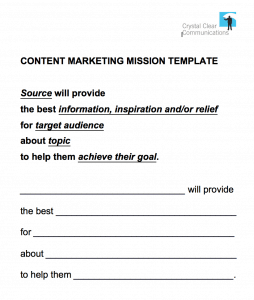
Add into your strategy:
• Buyer benefits. Quickly answer the question, “What’s in it for buyers?”
• Calls to action, both soft and hard.
Why do you need both two types of conversions – soft and hard? Because when someone answers yes to a small ask, the human consistency principle urges them to say yes to a bigger ask.
It’s wise to make a small ask (a soft conversion) before you make a big ask (such as a hard conversion that puts buyers into the demand pipeline).
Most teams hammer out a content marketing mission and strategy in a half-day workshop. Once you have a mission and strategy, give people a couple of weeks to absorb it.
Then organize a half-day session to develop your marketing message. Convene the same team that gave input to your strategy.
4. Create a message that hooks buyers in 7 seconds
A concise, clear, and consistent message helps you hook people’s attention fast – in as little as 7 seconds or 23 words. Seven seconds is the length of the average sound bite when people are quoted in news media.
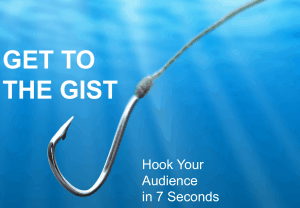
To overcome people’s short attention spans and make your message hit home, boil your message down to 7 seconds with a Message Map. A Message Map helps you say it, share it, present it, tweet it, blog it, post it, publish it, or debate it well.
What is a Message Map? It’s a simple intuitive tool that helps you:
• Tell your story in 7 seconds or 23 words.
• Keep it clear, concise, and consistent.
• Tell the same story in digital, print, and live media.
• Scale up the story as needed.
• Get everyone to sing from the same songbook.
• Gain buy-in and speed reviews.
Here’s an example of a 7-second Message Map for the Virgin Hotel Chicago.
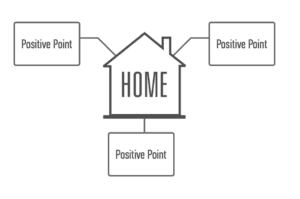
Co-create your Message Map as a team, so people understand, buy into, and use the same consistent message.
Why? Because the human brain equates consistency with credibility. You have to deliver a message consistently for audiences to believe it.
With a Message Map, you command attention as you answer the audience’s key question, What’s In It for Me? (WIIFM?)
Breakthrough with a concise message in 7 seconds. Then gracefully scale up your message to 2 minutes, 5 minutes, 20 minutes or more.
By delivering one main point, called the home base, backed up by 3 positive points, your message will be remembered. With a Message Map, you always have the right-sized message ready to go in any medium – live, print, or digital.
Build your path to success

To build a content marketing strategy from scratch, involve other people in co-creating your platform.
With your content marketing mission, strategy, and message in hand – plus buy-in from your co-creators – you’ll build a smooth path to launch content marketing successfully!
Related Posts
Want to make your marketing approval process easier?
Last week during my morning pace-with-coffee routine, I walked by a book my life partner Robert recently read: David Thorne’s Deadlines Don’t Care if...
How do you ensure marketing project success?
Have you ever worked on a marketing project, only to see it languish and never get completed? It’s frustrating when something you worked on...
Keep the Human Heart in Your Message
Without heart, everything may be lost. That hard lesson about messaging comes from the story of France Telecom and the famous last words of its CEO Didier Lombard. When consumers shifted to mobile...
5 Steps to Map Content Marketing to the Buyers’ Journey
To succeed, content marketing must make the buyers’ path clear. Buyers seek to answer specific questions during each step in the buying journey. And...



